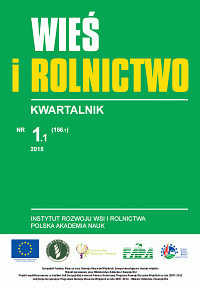From disappearance to recovery: family farming in Central Europe Questioning the path dependency hypothesis
From disappearance to recovery: family farming in Central Europe Questioning the path dependency hypothesis
Author(s): Marie-Claude MaurelSubject(s): Social Sciences
Published by: Instytut Rozwoju Wsi i Rolnictwa Polskiej Akademii Nauk
Keywords: de-collectivisation; revival of family farms; consolidation of family farming; similarities and dissimilarities between the farm structures of CEECs small and large farms
Summary/Abstract: Family farming is organized in different forms in the countries of Central Europe where collectivisation had been implemented. Many of these forms are different than seen in other parts of Europe. The reprivatisation and revival of family farming systems has been seen to be a complex process dependent on many determining factors. This article addresses why the various types of farms have arisen, why they survive or fail as a result of a process of de-collectivisation. The inheritance of the organisational of farms from parent to child has had to be replaced and questions arise about historical ownership and how this explains present forms. Small and large farms are generally dominate the agrarian structure. In a number of countries the family farms of a medium and a large size is less significant. To explain this situation a re-evaluation of institutional changes must be conducted, especially in light of both historical and current bifurcation where smaller smooth changes to the system caused sudden ‘qualitative’ or topological changes. Institutional change has to be considered and analysed as a moment of gradual elimination of the collectivized system through a number sequences of causally related events, each at a different pace. The absence or the weakness of modern family farms is the result of an unfavourable mix of both informal and formal institutions that put pressure on the revival of family farming. The political and economic environment created during transitional periods gave an obvious comparative advantage to large-scale farms. These same institutional changes had no particular limiting effect on the survival of small subsistence farms. Path dependent mechanisms, as they can effect to outcomes at a single moment in time or to long run equilibria of a process, are not absolute and policies implemented by reformers tend to lead to path diversion creating a plurality of structural arrangements often inefficient. New structural dichotomy has appeared between agricultural systems based on a high concentration of land and the use of paid labour (the Czech case), and agricultural systems with more dual configurations that combine family and non-family labour (Hungarian and Lithuanian cases). Path shifting mechanisms have been in favour of the continuity of large farms being transformed into corporate holdings or partnerships. They consequently have inhibited the setting up of a sustainable family farming model. Dismantling collective farming might open different pathways, and these pathways from collectivism to post-collectivism are not straightforward. Consequently any consolidation of family holdings characteristic of market societies has been slow and is incomplete.
Journal: Wieś i Rolnictwo
- Issue Year: 166/2015
- Issue No: 1(1)
- Page Range: 79-105
- Page Count: 27
- Language: English

